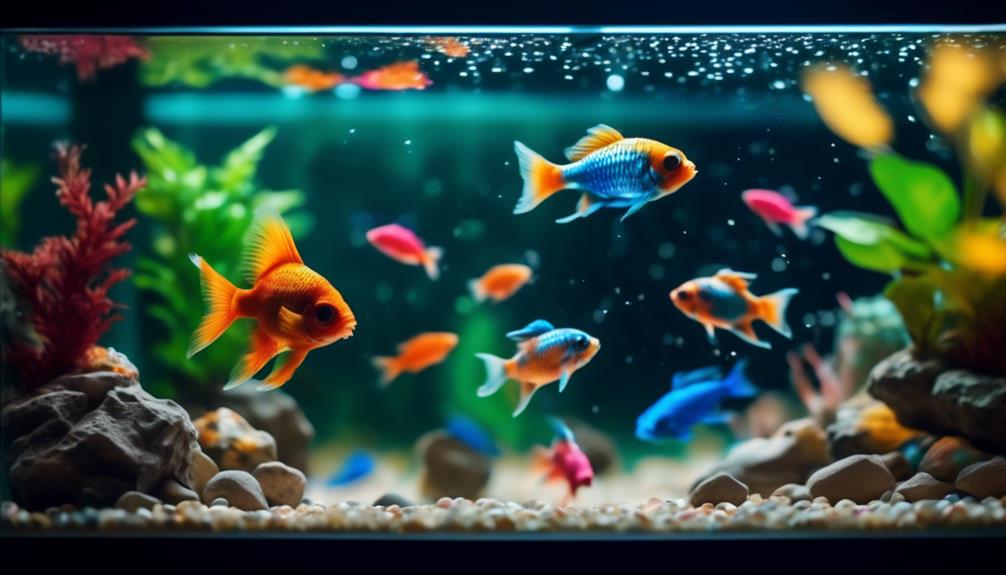Clear Currents: Pet Fish Tank Cleaning

Pet Fish Tank Cleaning: Are you tired of staring into a murky fish tank, struggling to spot your beloved pet fish? Look no further than the ultimate solution to your aquarium woes. This comprehensive guide not only provides you with step-by-step instructions on how to clean your fish tank effectively but also offers valuable tips and tricks to maintain a clean and healthy environment for your aquatic companions. With Clear Currents, you’ll uncover the secrets to crystal clear waters and vibrant, thriving fish. So, why settle for a lackluster tank when you can dive into the world of Clear Currents and transform your fish tank into a dazzling aquatic paradise?
Importance of Regular Fish Tank Cleaning
Regular fish tank cleaning is crucial for maintaining a healthy environment for your fish, as it removes waste and excess food from the substrate. Fish waste, uneaten food, and other debris can accumulate in the tank over time, leading to poor water quality and potentially harmful conditions for your fish. Regular cleaning helps prevent these issues and ensures that your fish have a clean and safe habitat.
One important aspect of fish tank cleaning is performing regular water changes. This involves replacing a portion of the tank water with fresh, clean water. Water changes help remove accumulated toxins and maintain proper water quality. They also help prevent temperature and pH swings, which can stress and harm your fish. The frequency of water changes depends on the size of your tank and the number of fish you have. As a general rule, it is recommended to perform a 25% water change every two weeks for most tanks, but larger tanks may require less frequent changes.
In addition to water changes, it is also important to clean the tank itself. For glass tanks, a non-abrasive glass cleaner can be used to remove algae and other residue from the walls. For acrylic tanks, it is essential to use a cleaner specifically designed for acrylic, as abrasive cleaners can scratch the surface. Regular cleaning of the tank also involves cleaning the filter media, which helps remove impurities from the water. This can be done by rinsing the media in aquarium water to preserve the beneficial bacteria.
Common Problems With Dirty Fish Tanks
When it comes to maintaining a clean and healthy environment for your fish, it is important to be aware of the common problems that can arise from dirty fish tanks. One common issue is excessive algae build-up. While algae is a sign of a healthy tank, too much of it can affect water quality and fish health. It can obstruct fish movement and turn the tank green, making it difficult for your fish to thrive. To prevent this, it is crucial to clean your fish tank correctly and regularly.
Another problem that may occur is filtration noise. If you notice loud noises coming from your filtration system, it could indicate that there is air stuck in the system. To resolve this, you can try re-priming the filtration. By doing so, you can ensure that your filtration system is working properly and providing the necessary filtration for your fish.
Fish health is also a concern when it comes to dirty fish tanks. If you notice your fish breathing heavily, it may be a sign of poor water quality. It is essential to test the parameters of both your tank and tap water before adding new water. If you are unsure about the health of your fish, it is always a good idea to consult a veterinarian.
Lastly, water clarity can be affected by various factors, including particles and color. Regular cleaning and the use of UVC clarifiers can help maintain water clarity. By keeping your fish tank clean and providing fresh water for your fish, you can prevent these common problems and ensure a clean and healthy environment for your fish.
Step-By-Step Guide to Cleaning a Fish Tank
To properly clean your fish tank, it is important to follow a step-by-step guide that ensures a thorough and effective cleaning process. Start by unplugging all electronic components and washing your hands thoroughly to prevent contamination of the tank. Next, use a gravel vacuum to remove fish waste and excess food from the substrate. This will help maintain a clean environment for your fish.
When it’s time to add new water, make sure it is at the same temperature as the tank to avoid shocking the fish. Additionally, add a de-chlorinator to remove chlorine and chloramine from the water, as these chemicals can be harmful to your fish.
After cleaning the tank and adding new water, it’s important to replace any tank décor that was removed. This will provide your fish with a familiar and stimulating environment.
Next, slowly pour in the treated water to avoid disturbing the fish or causing any sudden changes in the tank. Once the water is in, prime the filtration system to ensure it is working properly. It’s important to monitor the tank after cleaning to ensure the filter is functioning correctly.
If you encounter any issues during the cleaning process, such as a loud filtration system, heavy-breathing fish, or persistent algae, it’s important to troubleshoot and address these problems. If you’re unsure how to handle these issues, it may be best to seek professional advice.
Tips for Maintaining a Clean and Healthy Fish Tank
For optimal cleanliness and health, it is essential to follow these tips to maintain a clean and healthy fish tank. First and foremost, make sure to wash your hands thoroughly before cleaning the tank to prevent any contamination. Additionally, when changing the water, be cautious not to remove more than 50% of the tank water at a time. Drastic changes in temperature and pH levels can be harmful to your fish.
When reassembling the tank, it is important to replace the decor and pour in treated water slowly. This will help to minimize stress on the fish. Don’t forget to prime the filtration system as well. This ensures that it is working properly and effectively removing waste from the tank.
If you encounter any issues with the filtration system, such as loud noises or heavy breathing in your fish, try re-priming the filtration system. If the problem persists, it may be necessary to test the water parameters and consult a veterinarian for further advice.
Dealing with algae is a common concern for fish tank owners. Remember, there’s no need to worry about a little bit of algae. However, if the tank becomes excessively green or if the algae obstructs the movement of your fish, it’s time to take action. Consider adjusting the lighting, reducing nutrient levels, or adding algae-eating fish or snails to help keep the algae under control.
Professional Fish Tank Cleaning Services
Did you know that professional fish tank cleaning services offer comprehensive cleaning and maintenance for your aquarium? These services are designed to ensure that your tank remains clean and healthy, providing a safe environment for your fish. Professional cleaners are equipped with the knowledge and tools necessary to perform thorough cleaning, including gravel vacuuming and water changes.
Fish cannot survive in dirty water, as it can lead to a build-up of harmful toxins. Regular cleaning is essential to remove waste, excess food, and other debris from the tank. Professional cleaners recommend using a gravel vacuum to clean the substrate, as it helps to remove dirt and waste that settle on the bottom of the tank.
In addition to cleaning, professional services can also help with maintenance tasks such as replacing filter media. The filter plays a crucial role in maintaining water quality by removing impurities and waste. Over time, the filter media can become clogged and less effective, so it’s important to replace it regularly.
Another aspect of professional fish tank cleaning services is the proper disposal of waste tank water. It is not recommended to simply pour the water down the drain, as it can harm the environment. Instead, professional cleaners can properly dispose of the wastewater, ensuring that it does not contaminate local water sources.
If you notice that your fish tank is consistently dirty, it may be a sign that your tank requires professional cleaning. Regular maintenance is essential to prevent the build-up of harmful substances and maintain a healthy environment for your fish. By investing in professional fish tank cleaning services, you can ensure that your aquarium remains clean, vibrant, and safe for your aquatic pets.
Pet Fish Tank Cleaning Frequently Asked Questions
How Do You Clean a Pet Tank?
To clean your pet tank, start by removing excess food and debris, then clean artificial decorations. Maintain water temperature and use proper filtration. Regularly change the water, test parameters, monitor pH levels, and prevent/treat fish diseases.
What Not to Do When Cleaning a Fish Tank?
When cleaning a fish tank, avoid common mistakes like using harmful cleaning products or overcleaning. Prevent stress by avoiding sudden temperature changes and safely handling the fish. Maintain the nitrogen cycle and dispose of tank waste properly.
Can You Clean a Fish Tank With Dawn Dish Soap?
You shouldn’t clean a fish tank with Dawn dish soap. It can harm your fish and leave behind harmful residues. Instead, use fish-safe cleaning products or natural methods to maintain a healthy environment for your pets.
How Do I Get Rid of Algae in My Fish Tank Gravel?
To get rid of algae in your fish tank gravel, try natural remedies like using algae-eating fish or snails. Regularly clean the gravel bed with a gravel vacuum and use algae scrubbing tools. Avoid excessive lighting and nutrients to control algae growth.
Conclusion
In conclusion, regularly cleaning your fish tank is crucial for the health and well-being of your pet fish. By following the step-by-step guide provided in Clear Currents: Pet Fish Tank Cleaning, you can effectively remove waste, change water, and troubleshoot common issues. Additionally, maintaining a clean and healthy fish tank requires proper handwashing, balancing lighting and nutrients, and using the right tools for algae removal. Remember, a clean fish tank is essential for creating a safe and comfortable environment for your fish to thrive.








